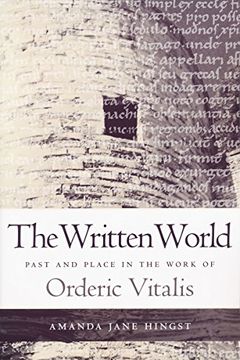Reseña del libro "The Written World: Past and Place in the Work of Orderic Vitalis (en Inglés)"
The Anglo-Norman monk Orderic Vitalis (1075-c.1142) wrote his monumental, highly individual Historia Ecclesiastica as an exercise in monastic discipline intended to preserve the events and character of Christendom for future generations. Though cloistered since childhood in a Benedictine monastery near Normandy's southern border, Orderic gained access to an intellectual world that extended from Scotland to Jerusalem through his engagement with texts and travelers that made their way into his monastic milieu. His Historia Ecclesiastica, with a breadth of vision unparalleled in its time, is a particularly fertile source for an investigation of concepts of space and historiography in the high Middle Ages. In The Written World: Past and Place in the Work of Orderic Vitalis, Amanda Jane Hingst draws on the blend of intellectual intimacy and historiographical breadth in Orderic's writings to investigate the ways in which high medieval historians understood geographical space to be a temporally meaningful framework for human affairs. Hingst explores Orderic's manipulation of the classical geographical tradition, his balancing of spatial scale between the local and the universal, and his sophisticated and original utilization of the new intellectual currents of the twelfth century. She argues that Orderic, along with some of his contemporaries, interpreted Christendom's terrain not merely as a static stage for human action but as a meaningful element in human history. Using a theoretical framework marrying modern spatial theory with medieval philosophical traditions, Hingst suggests that, at its most nuanced, medieval historiography affirmed the symbolic topography of Christendom by linking history and geography in such a way that they mutually forged and reinforced each other. With a clarity of style and ideas, Hingst makes available to both students and trained scholars a fascinating account of a heretofore underappreciated medieval figure and his work.“Amanda Hingst has written a wonderful book―learned, brilliant in concept, and graceful in execution. She provides the most thorough reading of the full text of the most interesting historian of the twelfth century, Orderic Vitalis, and, in so doing, contributes significantly to the study of historiography and the reading of the history of the period.” ―Robert M. Stein, Doris and Carl Kempner Distinguished Professor of Humanities, Purchase College“Orderic Vitalis is one of the great twelfth-century historians who is both cursorily well-known and hardly known at all in any deep sense. Amanda Hingst offers us a substantial remedy for that lack by taking seriously an aspect of reality that Orderic (but not his modern readers) took seriously: the readable natural world of landscape, traversable space, and dramatic weather, all fraught with meaning for history. Hingst writes from a well-chosen critical place uniting the historian's specificity with the literary critic's sensitivity to map the topography of meanings that Orderic inscribed into the physical settings for the historical events he narrated. Hingst's clever choice of interpretive focus respects both medieval and modern senses of historical reality, and contributes significantly to our still growing awareness of the depth and complexity of medieval historical writing.” ―Nancy Partner, McGill University “The Written World lives up to its audacious title. Wry, cool, and unflappably alert, it makes brilliant sense of Orderic Vitalis's baffling and luxuriant composition. We have here the work of a historian who can teach literary scholars something about how to read.” ―Steven Justice, University of California, Berkeley “The Written World is a wonderful, innovative, and beautifully written study of Orderic Vitalis’s Historia Ecclesiastica. Amanda Hingst vividly evokes the meaning and function of history for an Anglo-Norman monk at the end of the eleventh century and the beginning of the twelfth. She emphasizes how geographical space provided a temporal framework through which Orderic Vitalis narrated and experienced historical events. The landscape of Christendom, far from being an unchanging backdrop to human deeds, actively participated in the history of the world. Heaven was glimpsed on earth as God manipulated fields and streams, trees and clouds, tempests and dirt with a divine purpose. This book is a major contribution to the intellectual history of the High Middle Ages.” ―Mark Gregory Pegg, Washington University

